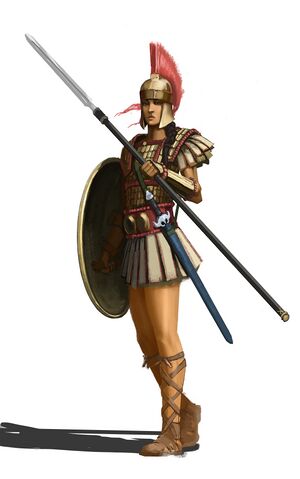Hostilii
This article is incomplete because it is pending further input from participants, or it is a work-in-progress by one author. Please comment on this article's talk page to share your input, comments and questions. Note: To contribute to this article, you may need to seek help from the author(s) of this page. |
Hostilii (singular: Hostilius) were one of the main infantry elements of Sabrian legions throughout the entirety of the time of the Sabrian Empire. Originally, Hostilii consisted of the oldest and wealthiest members of the military, but it gradually transitioned into a rank that denoted the most veteran of the core of Sabrian troops outside of the elite Veturii.
Equipped with heavy scale linothorax armor, a circular convex shield, a crested helm, and armed with both a spear and sword, the Hostilii formed part of the second line of battle alongside the Constantii and behind the Hastati. Hostilii often fought in a shallow shield-wall formation and were supported by a variety of light troops, often bolstering areas where the Hastati or Constantii line were beginning to buckle.
The Hostilii derive their name from the Mos Maiorum goddess Hostilia who was often depicted to be a master of varying types of weaponry. Although it was not required, many of the Hostilii were members of the Mos Maiorum Cult of Preservation.
History
Creation
Based on contemporary accounts from authors before the creation of the office of Legatus, the Sabrian Army during the earliest stages of the conquest of the archipelago was not initially organized into specific purpose-driven units. Instead, it was organized into simple formations based on either melee armament or ranged equipment and it was only after Atria Aurelia was elected as first Legatus did designations based on specific roles begin to appear.
The first written mention of the Hostilii was in 802 BCE in the wake of the Sabrian conquest of the island of Sarissita. Atria—who had been in command of the city-state's armies since departing Kalaris—postulated that instead of fielding mixed formations the performance of the Sabrian warmachine could be optimized greatly by defining specific roles and units.
At the time, much of the Sabrian military consisted of citizen-militia who were equipped with what they could afford. This resulted in a relatively heterogeneous collection of weaponry which was eventually broken down into those armed with spears (Hastati), swords (Constantii), javelins (Iaculii), and bows (Sagittarii). Members of the military who could afford both a spear and sword, commonly wealthier citizens of Sabria, posed an interesting problem. At the suggestion of her advisor Aquillia Haterius, Atria created a designation for multi-purpose infantry which became the Hostilii.
In becoming masters of the spear, sword, and shield, these warriors aspire to become the embodiment of Hostilia herself. As such, we shall call them Hostilius and they shall serve as both Hastati and Constantii in our great army.
— Atria, describing the reasoning behind the nomenclature of the Hostilii.
Aurelian Era
During the first decade of Atria’s conquest of the Cacertian archipelago, the Hostilii remained defined as the wealthiest of Sabria’s military by their ability to afford the necessary equipment required for the distinction. This changed, however, in 793 BCE in conjunction with the growing economic wealth of the Sabrian Empire and the eventual state-sponsorship of its army. Atria and the Sabrian Senate went on to abolish the land and wealth requirements, converting the Hostilii into veteran heavy infantry maniples.
It was also during this change that the Hostilii were removed from the frontline of Sabrian battle formations and moved into the second line as a veteran reserve. Since the requirement for membership of Hostilii now focused on battle experience, this made the units more elite but also significantly smaller. Despite this change, however, Atria and her generals were mostly characterized by their aggressive use of the Hostilii as a strong central foundation to their battle lines.
